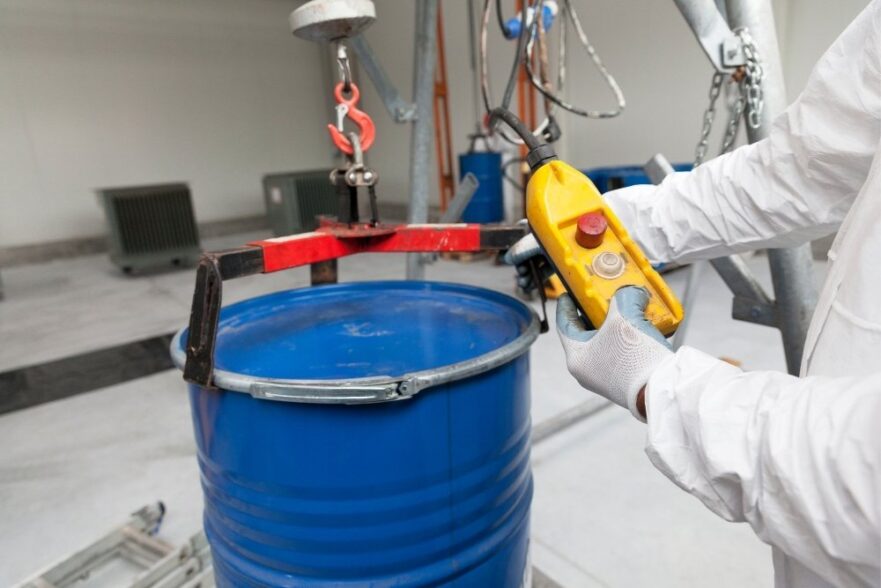Liquid hazardous waste can be a very harmful material to people, animals, and the environment. It is a byproduct from industries such as construction, water treatment systems, manufacturing, automotive garages, laboratories, hospitals, and a multitude of other industries.
In order for it to be disposed of properly, there are procedures and steps that a company can take to make sure they are not causing harm to the environment, or the people and animals around them.
Before we get into those steps, let’s first take a look at what hazardous waste actually is and why it’s important to know how to get rid of it properly.
What is hazardous waste?
Hazardous waste is anything that causes a potential or substantial threat to the health of the public, or the environment.
The majority of hazardous waste materials can be characterized as ignitable, reactive, corrosive, and/or toxic. This waste can be in liquid form, sludge form, gas form, solid form, or even a paste form.
When hazardous liquid waste is created, it can end up in the water streams, in the ground, and in the air. Certain toxins can remain in the environment for long periods of time. When these hazardous liquid waste materials are left for a long period of time, the animals and humans within the area usually end up absorbing the substance.
Why knowing how to get rid of liquid hazardous waste is important
Not only can hazardous waste be an extremely toxic substance for animals, humans and the environment, but should a company not get rid of this waste correctly, it can result in huge financial losses through lawsuits, settlements, fines and further investigation.
The removal of such toxic waste is very heavily legislated, and violations may result in heavy fines.
What are the hazardous waste disposal and recycling laws in Canada?
In Canada, hazardous waste is managed by the municipal, provincial, and federal government, which all create fines for the improper disposal of hazardous waste.
With municipal governments, they deal within their own jurisdictions with collection of recycling, composing, and disposal programs. The majority of municipalities are for house products.
Provincial and territorial governments have put measures into place and created a criteria for hazardous waste generators, carriers, and treatment facilities to get proper licensing. In addition, this allows control over movements of hazardous waste within their given jurisdictions.
You then have the federal government which regulates the movements and transfers of waste and recyclable substances that are hazardous, while also maintaining global and international agreements. With the CEPA act of 1999, as stated in this document on the Canadain government website, it gives the act the authority to:
- ‘set criteria to assess the environmentally sound management of wastes and hazardous recyclable materials and to refuse to permit import or export if the criteria are not met; ‘
- require exporters of hazardous wastes destined for final disposal to submit export reduction plans;
- regulate the export and import of prescribed non-hazardous wastes for final disposal;
- and control inter-provincial movements of hazardous wastes and hazardous recyclable materials.
On top of these regulations, Environmental Canada is also looking to improve their regulatory initiatives for waste removal in the following areas:
- developing new PCB regulations that will strengthen existing controls and propose deadlines for ending the use and storage of PCBs;
- and revising the Interprovincial Movement of Hazardous Waste Regulations to align the definitions of hazardous waste and hazardous recyclable material and the new movement document with those under the Export and Import of Hazardous Wastes Regulations.
How to properly manage hazardous waste materials
Registering as a Hazardous Waste Generator on the HWIN network is an important step to becoming compliant. Companies, regardless of size, are required to register the type of hazardous waste their manufacturing process generates.
This can be any sort of materials such as solvent waste, water waste, acids, chemicals, contaminated sludges, sandblasting media, pesticides, industrial lubricants, coolants, glycols, oils, solvent rags, etc.
This allows the Ministry of the Environment to understand the type of waste being generated, ensuring companies develop proper operational procedures to safely dispose of such types of hazardous waste.
A part of that procedure is partnering with a trusted and licensed hazardous waste management company that not only provides service to pick up hazardous waste, but also offers guidance to improve operations.
During a service pick up, a manifest is generated indicating volumes and types of hazardous waste being picked up, transported and processed. Copies will remain with the waste generator, the Ministry of the Environment, and the licensed carrier/transportation company ensuring transparency across all parties.
The manifest ensures the responsible management of hazardous waste as it shows a paper trail of where the waste was generated and where it was processed. This encourages companies to adhere to regulations and avoid any unnecessary fines, while doing their part to safeguard the environment.
Make hazardous waste a priority!
Hazardous waste material is just that, hazardous. If it is not disposed of and recycled properly, it can affect humans, animals, and the environment. With the ever-growing demand for environmentally-friendly solutions to problems that are hazardous, it is vitally important for companies to know how to properly manage their liquid hazardous waste.
It is important to recycle and reuse what you can, as well as getting rid of the toxic waste that cannot be recycled. With options like Maratek Environmental, you can manage your liquid hazardous waste, while still complying with municipal, provincial, and federal guidelines.
Want to find our more? Contact Maratek Environmental today – a fully licensed hazardous waste management company that has helped manufacturing companies in Ontario stay compliant for over 50 years.

